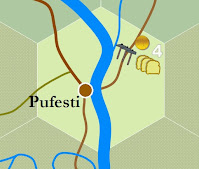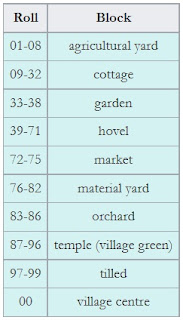The last village came together so quickly, the temptation is to adjust the table to ensure a few less cottages and hovels. Making tables for yourself, you'll bump into that inclination constantly. Experience teaches not to fiddle, but to trust one's instinct for the original numbers until getting a decent sampling of test runs, at least 20 or 30. That's not enough work that we can't throw it away and start from scratch, if we feel that's needed, or that can't be let alone, since in the long run it will remain as a tiny aberration in the overall process. As such, I'll go with the table as written.
I'll start with a real village this time, a place call Pufesti. Three hammers, on the Siret River in Bukovina, eastern Romania. The scale of the small map is 6.67 miles per hex; but obviously, like before, we want block-sized hexes, 435 ft. per hex.Just as a 20-mile hex makes a group of seven "6-mile" hexes, we can continue that zoom further. Zoom once to "2-mile" hexes (2.22 mi. diameter), zoom a 2nd time to "uberblocks" that are 0.741 mi. in diameter, and zoom a 3rd time to block-size (0.247 mi., or 435 ft.). This translates to the same hex shown on the left to a 27-hex diameter area, as shown below. First, with the old Pufesti hex & details showing:
And now with no background, with the circle indicating the location of Pufesti:
Essentially, all I'm doing is taking the old Gygax suggestion from p.47 of the original DMG:
Coming from mapmaking long before I started playing D&D, I read such snippets of possibility with considerable interest, finding ways to apply this idea in my own way.
As noted from the pictures above, we can see the small circle of Pufesti isn't a symbol that's markedly bigger than what a village might be; if anything, the tiny brown circle of Pufesti is smaller than the actual place. Overall, I'm hoping this assembly of map scales and the use of hexes helps the reader comprehend a tactile sense of how big a 6-mile hex is, and how translatable this is to much bigger scales. Remember, each of the 435 ft. block hexes above is only 81 combat hexes across — that's the size of the large partial black hex on this combat map:
Ah, okay, but we're here to generate a village. We can start by assigning Pufesti an even 500 people, for simplicity. Unlike our earlier example, Pufesti has 3 hammers, not 2; this means a few things are certain. There's a town center but there's also a church; there's also a market, and there's a small bridge across the river. Because there's some cottage crafting here, there's at least one group of cottages. So before we start, we've already accounted for 105 people. That's okay, we have plenty of room for others.
Laying out these places, arbitrarily laying out the village center and the bridge first (and giving no weight points to the bridge, but you may feel otherwise) we get the shown collection of places. I've adjusted the three incoming roads (later, I'll transform the colouring of these). They'll need to be tweaked as places turn up. The unfamiliar brown hex near the bottom of the map is the market, which is little more than an open dirt pad with pens for animals and a wall surrounding a few permanent buildings. I can't say my artwork here is astounding, I only want to get the point across.
The process works just as it did before. The main question is, do we take another market if it shows up? Do we take another village centre? The answer is yes, if we can make it make sense, given the layout. A second market must go next to the first; a second village centre can go anywhere. Because of the size of the village, a second temple wouldn't make sense, unless this were a polytheistic region. As it is, this is western Romania, so we'd expect to have only one church.
Laying out these places, arbitrarily laying out the village center and the bridge first (and giving no weight points to the bridge, but you may feel otherwise) we get the shown collection of places. I've adjusted the three incoming roads (later, I'll transform the colouring of these). They'll need to be tweaked as places turn up. The unfamiliar brown hex near the bottom of the map is the market, which is little more than an open dirt pad with pens for animals and a wall surrounding a few permanent buildings. I can't say my artwork here is astounding, I only want to get the point across.
The process works just as it did before. The main question is, do we take another market if it shows up? Do we take another village centre? The answer is yes, if we can make it make sense, given the layout. A second market must go next to the first; a second village centre can go anywhere. Because of the size of the village, a second temple wouldn't make sense, unless this were a polytheistic region. As it is, this is western Romania, so we'd expect to have only one church.
I'll repost the random table. Whatever the results are, and should we later consider expanding the idea here into further details, one thing we must remember is that the table is made for us; we are not made for the table. I don't recommend ignoring a roll, but occasionally there will be good reasons for deciding there are too many material yards or village centres. Additionally, we should always strive to think of something new that can be added for later instances of using the table again.
Rolling, then, I get a "garden" between the village centre and the market. This isn't the sort that people visit, but a space where vegetables and other intensive produce is grown; often such places were communal. There's no reason not to locate this directly adjacent to the village centre, as "density" isn't part of the overall scheme — whereas food growth is essential. A village isn't just a small town; it has different priorities, a different outlook. Later, should the village grow into a town, where space may become a premium, the garden hex would be pulled out and townhouses or workshops put in its place. But vegetable gardens are fine for a village.
Then we add another set of cottages between the bridge and the village centre (pop. 155) and we have a simple star.
In all honesty, the actual laying out of the hexes, even the upgrading of the weighted hexes around the outside, is quite simple. I've built this nice collection of image hexe that can be turned this way and that to give some sense of shape and colour. But the process of writing about the generation is losing my interest, fast. Even though I haven't shown all the little symbols I made, I'm going to call the post at this point. And I don't believe I'll make a third village [sorry], because I don't see it as adding anything new to the concept.
It's very simple from here. What matters is building a believable, richly designed space for the players to occupy, going beyond every village being immediately associated with the inn, tavern and convenient market. Make the players comprehend the feel of life here — try to shake them out of the complaceny so they stop taking your world for granted. These are people living in this village, whose small problems may not be dungeon rooms or vast treasure hordes ... but they are potential companions for those dungeons. There are youngsters here who want to learn, friends who want to feed the party and look after their wounds and hear their stories. It's a place for the players to ground themselves, to identify as something worth protecting, and think whistfully about when everything in the dungeon goes sour.
I know that for many players, those who think the shallower the campaign, the better, this seems all maudlin and time wasting. I assure you, it's not. Dungeons are what you fight against. Villages are what you fight for.








Those last two sentences say it all. My party recently turned their backs on an offer from powerful wizard to keep a promise made months (and levels) ago to a small rural village of <250 souls.
ReplyDeleteSorry this didn't hold your interest, but I understand. Town maps are the least used and least needed of any RPG map: I was hoping you'd have a eureka somewhere along the line and find something that might challenge that.
ReplyDeleteAs it is I still think the bones of the generator, the blocks themselves, are an excellent idea and worth holding on to. Even more than a town generator, a block generator (subtable?) that offered variance among the individual zones would allow for creating neighborhoods and villages with character.
Really liked the return of the old fort battle image. Excellent sense of scale there, and could make even these two smaller villages into epic conflicts.
I also think there's a benefit. All I'm saying at this point is that it's easier to simply plunk in the layout than to endlessly describe each niggling point of it. Most of the outcome ought to be self-evident; doesn't need me to pedantically sling words for no good purpose. But as far as the actual layout, I like the idea of a set of pages that progressivly zoom downwards into the same village, one for each level of zoom.
ReplyDeleteSub-blocks, for instance, are 145 ft. across (29 combat hexes); the next zoom down has hexes at 48.33 ft. across. If I had some meaningful artistry in me, each sized map could be made, with each providing its own level of interaction and exposition. But alas, I'm not an artist map-maker. I'm a diligent line-drawer and that's as far as it goes.